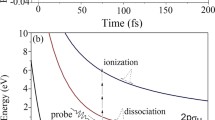Abstract
We consider the Pauli-Fierz Hamiltonian with dynamical nuclei and investigate the transitions between the resonant electronic energy levels under the assumption that there are no free photons in the beginning. Coupling the limits of small fine structure constant and of heavy nuclei allows us to prove the validity of the Born-Oppenheimer approximation at leading order and to provide a simple formula for the rate of spontaneous decay.
Similar content being viewed by others
References
Abou Salem W.K., Faupin J., Fröhlich J., Sigal I.M.: On theory of resonances in non-relativistic QED and related models. Adv. in Appl. Math. 43, 201–230 (2009)
Bach V., Fröhlich J., Sigal I.M.: Spectral Analysis for Systems of Atoms and Molecules Coupled to the Quantized Radiation Field. Commun. Math. Phys. 207, 249–290 (1999)
Betz V., Goddard B., Teufel S.: Superadiabatic transitions in quantum molecular dynamics. Proc. R. Soc. Lond. Ser. A Math. Phys. Eng. Sci. 465, 3553–3580 (2009)
Betz V., Goddard B.: Accurate prediction of non-adiabatic transitions through avoided crossings. Phys. Rev. Lett. 103, 213001 (2009)
Faupin J.: Resonances of the Confined Hydrogen Atom and the Lamb-Dicke Effect in Non-Relativistic QED. Ann. Henri Poincaré 9, 743–773 (2008)
Griesemer M., Lieb E.H., Loss M.: Ground states in non-relativistic quantum electrodynamics. Invent. Math. 145, 557–595 (2001)
Hainzl C., Seiringer R.: Mass renormalization and energy level shift in non-relativistic QED. Adv. Theor. Math. Phys. 6, 847–871 (2002)
Hagedorn G.A., Joye A.: A time-dependent Born-Oppenheimer approximation with exponentially small error estimates. Commun. Math. Phys. 223, 583–626 (2001)
Hagedorn G.A., Joye A.: Determination of non-adiabatic scattering wave functions in a Born-Oppenheimer model. Ann. Henri Poincaré 6, 937–990 (2005)
Hislop, P.D., Sigal, I.M.: Introduction to Spectral Theory with Applications to Schrödinger Operators. Applied Mathematical Sciences 113, Berlin-Heidelberg-NewYork: Springer, 1996
Hasler D., Herbst I., Huber M.: On the Lifetime of Quasi-stationary States in Non-Relativistic QED. Ann. Henri Poincaré 9, 1005–1028 (2008)
Hunziker W.: Distortion analyticity and molecular resonance curves. Ann. Inst. H. Poincaré 45, 339–358 (1986)
Jahnke T., Lubich C.: Error Bounds for Exponential Operator Splittings. BIT 40, 735–744 (2000)
Lasser C., Teufel S.: Propagation through conical crossings: an asymptotic semigroup. Comm. Pure Appl. Math. 58, 1188–1230 (2005)
Lieb E.H., Loss M.: Existence of Atoms and Molecules in Non-Relativistic Quantum Electrodynamics. Adv. Theor. Math. Phys. 7, 667–710 (2003)
Martinez A., Sordoni V.: On the time-dependent Born-Oppenheimer approximation with smooth potential. Comptes Rendu Math. 334, 185–188 (2002)
Martinez, A., Sordoni, V.: Twisted Pseudodifferential Calculus and Application to the Quantum Evolution of Molecules. Mem. AMS 200(936) (2009)
Nenciu G.: Linear Adiabatic Theory, Exponential Estimates. Commun. Math. Phys. 152, 479–496 (1993)
Panati G., Spohn H., Teufel S.: Space-adiabatic perturbation theory. Adv. Theor. Math. Phys. 7, 145–204 (2003)
Panati G., Spohn H., Teufel S.: The Time-Dependent Born-Oppenheimer Approximation. ESIAM: Math. Model. and Num. Anal. 41, 297–314 (2007)
Reed, M., Simon, B.: Methods of Modern Mathematical Physics. I: Functional Analysis. London-NewYork: Academic Press, 1978
Reed, M., Simon, B.: Methods of Modern Mathematical Physics. IV: Analysis of Operators. London-NewYork: Academic Press, 1978
Simon B.: Resonances and Complex Scaling: A Rigorous Overview. Int. J. Quant. Chem. 14, 529–542 (1978)
Spohn H., Teufel S.: Adiabatic decoupling and time-dependent Born-Oppenheimer theory. Commun. Math. Phys. 224, 113–132 (2001)
Tenuta L.: Quasi-static Limits in Nonrelativistic Quantum Electrodynamics. Ann. Henri Poincaré 9, 553–593 (2008)
Tenuta L., Teufel S.: Effective dynamics for particles coupled to a quantized scalar field. Commun. Math. Phys. 280, 751–805 (2008)
Teufel S.: A Note on the Adiabatic Theorem Without Gap Condition. Lett. Math. Phys. 58, 261–266 (2001)
Teufel, S. Adiabatic Perturbation Theory in Quantum Dynamics. Lecture Notes in Mathematics 1821, Berlin-Heidelberg-New York: Springer, 2003
Wachsmuth, J., Teufel, S. Effective Hamiltonians for Constrained Quantum Systems. http://arxiv.org/abs/0907.0351v3 [math-ph], 2009
Zhislin G.M.: Discussion of the spectrum of the Schrödinger operator for systems of many particles. Tr. Mosk. Mat. Obs. 9, 81–128 (1960)
Author information
Authors and Affiliations
Corresponding author
Additional information
Communicated by I. M. Sigal
This work was supported by the German Science Foundation (DFG).
Rights and permissions
About this article
Cite this article
Teufel, S., Wachsmuth, J. Spontaneous Decay of Resonant Energy Levels for Molecules with Moving Nuclei. Commun. Math. Phys. 315, 699–738 (2012). https://doi.org/10.1007/s00220-012-1547-3
Received:
Accepted:
Published:
Issue Date:
DOI: https://doi.org/10.1007/s00220-012-1547-3



